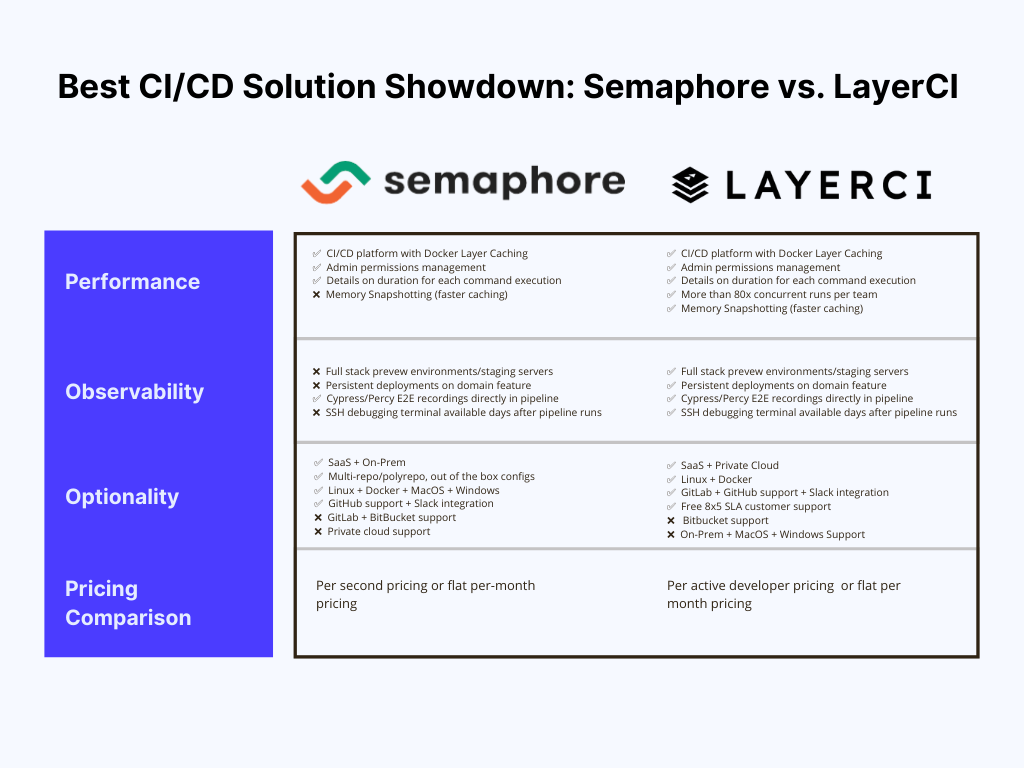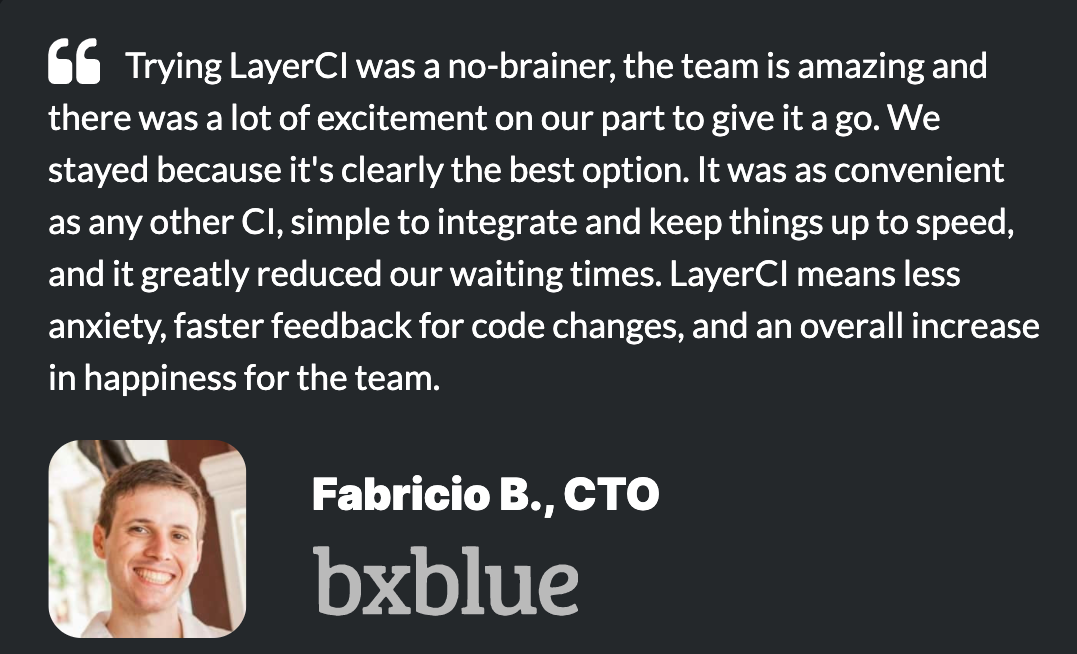

Summary:
- Why is CI/CD important?
- Is Semaphore the best CI/CD solution for your business?
- webapp.io capabilities missing in Semaphore
- Semaphore vs. webapp.io comparison summary
- Why businesses switch to webapp.io
- How to switch from Semaphore to webapp.io
1. Why is CI/CD important?
A key trend has emerged in the fastest-growing companies in the technology ecosystem: great DevOps practices. Companies like Netflix, Amazon, Facebook, Etsy and Target are excellent examples of this. Setting up a Continuous Integration/Continuous Deployment service is the first step to having a modern DevOps culture for high-performing software organizations. Read on to hear more about CI/CD using Semaphore or webapp.io, common tools for developer productivity.
2. Is Semaphore the best CI/CD solution for your business?
What is Semaphore?

Rendered Text (Semaphore parent company) was founded in 2011 by two software developers, Marko Anastasov and Darko Fabijan, who were searching for a way to make the CI/CD process faster and easier for every developer. An appropriate CI/CD platform for both open source projects and private projects, Semaphore helps developers improve efficiency and catch bugs before end-users of the product see them. Dedicated to ongoing improvement, the team released Semaphore 2.0 in 2018 with a number of new features, and offer ongoing support and updates. The information provided in this blog post is based on Semaphore 2.0's feature offering.
Why use Semaphore?
Offering plenty of flexibility in different environments, Semaphore is deployable to any cloud or app store, and can run jobs in a Docker, MacOS, or Linux environment (with sudo access). In addition, Semaphore supports iOS projects and Android. They promise the fastest CI/CD service on the market, and have a large community spanning 100+ countries.
Semaphore CI Pricing
Semaphore offers several traditional pricing tiers, with a free use tier for open source developers or personal hobby use (which includes $10 of free credits/up to 1300 build minutes each calendar month), a pay-as-you-go offering, a flat pricing (contact their customer success team), and an Enterprise Cloud offering.
Their default pay-as-you-go offering allows you to scale your developer's CI/CD resources as your team's software projects scale, on a dollar-per-second basis. This tier, listed on the pricing page for a number of machine types, is as following:
- Linux-2 (2 vCPU 4GB RAM) - $0.000125/sec
- Linux-4 (4 vCPU 8GB RAM) - $0.000250/sec
- Linux-8 (8 vCPU 16GB RAM) - $0.000500/sec
- macOS-4 (4 vCPU 8GB RAM) - $0.000500/sec
- macOS-8 (8 vCPU 16GB RAM) - $0.001000/sec
3. webapp.io capabilities missing in Semaphore
Why choose webapp.io for your CI/CD solution? Below we have highlighted some key features that webapp.io provides:
| WEBAPP.IO CAPABILITY | FEATURE DESCRIPTION |
|---|---|
| Memory snapshotting to cache comprehensive test pipelines | webapp.io is the only CI vendor on the market with memory snapshotting capabilities that effectively cache time-consuming tests. |
| On-demand staging environments - preview environments before merge | Preview changes faster with webapp.io's full stack preview environments right in your browser, allowing high-fidelity copies of your production environments perfect for QA, stakeholder demos, or code reviews. |
| Persistent staging environments on your domain | webapp.io Deployments is an extension of the Preview Environments feature. |
| Version control system (VCS) GitLab support | webapp.io supports GitLab users, a VCS Semaphore currently does not support. |
| SSH Terminal advanced capabilities | webapp.io's SSH debugging terminal lasts for days after the test pipeline ran, making it easier to go back and fix issues right from within the testing dashboard without having to rerun the pipeline. |
4. Semaphore vs. webapp.io Comparison Summary
At first glance, it can be hard to tell which cloud solution you should use for your DevOps needs. Both companies have pros/cons based on your company's needs. Some common performance considerations are outlined below:
| Performance | Semaphore | webapp.io |
| CI/CD Platform | ✅ | ✅ |
| More than 50x concurrent runs per team | ✅ | ✅ |
| Docker Layer Caching (DLC) | ✅ | ✅ |
| Memory Snapshotting | ❌ | ✅ |
| Details on duration for each command execution | ✅ | ✅ |
| Browsable artifacts and secret management | ✅ | ✅ |
| Admin Permissions Management | ✅ | ✅ |
| API | ✅ | ✅ |
| Observability | ||
| Full stack Preview Environments for visual reviews and staging | ❌ | ✅ |
| Persistent Staging Deployments on your own domain that autostop | ❌ | ✅ |
| E2E tests (with Cypress, Percy, Reflect.run) automatically viewable in pipelines | ✅ | ✅ |
| SSH debugging terminal available | ✅ | ✅ |
| Optionality | ||
| Hosted SaaS Version | ✅ | ✅ |
| GitHub Support | ✅ | ✅ |
| GitLab + Self-Hosted GitLab Support | ❌ | ✅ |
| Bitbucket Support | ❌ | ❌ |
| Slack Notifications | ✅ | ✅ |
| Admin Permissions Management | ✅ | ✅ |
| Linux VM Support | ✅ | ✅ |
| Docker VM Support | ✅ | ✅ |
| MacOS VM Support | ✅ | ❌ |
| Private Cloud Support | ❌ | ✅ |
Multirepo and Polyrepo support | ✅ | ✅ |
| Full-time customer support | ✅ | ✅ |
| Out of the box support for most popular programming languages and frameworks | ✅ | ✅ |
6. Why do businesses switch from Semaphore to webapp.io?
Often, this switch can be prompted by developers wanting further customization, experiencing slow run times, and accruing unpredictable costs. For a detailed example of why BxBlue, a Brazilian Fintech company, switched from Semaphore to webapp.io, check out this blog post.
The CTO of BxBlue on why they switched from Semaphore CI to webapp.io:

7. How to switch from Semaphore to webapp.io
Looking for the best Semaphore alternative? We care about helping developer teams find the optimal way to set up their organization's continuous integration and continuous delivery pipeline.
If you'd like Semaphore migration support, or are looking for the enterprise plan, feel free to email [email protected]
You can check out our official documentation, and we're more than happy to provide additional resources particular to your workflow or specific project. Want to try it out for yourself? Start a free trial of webapp.io here.
